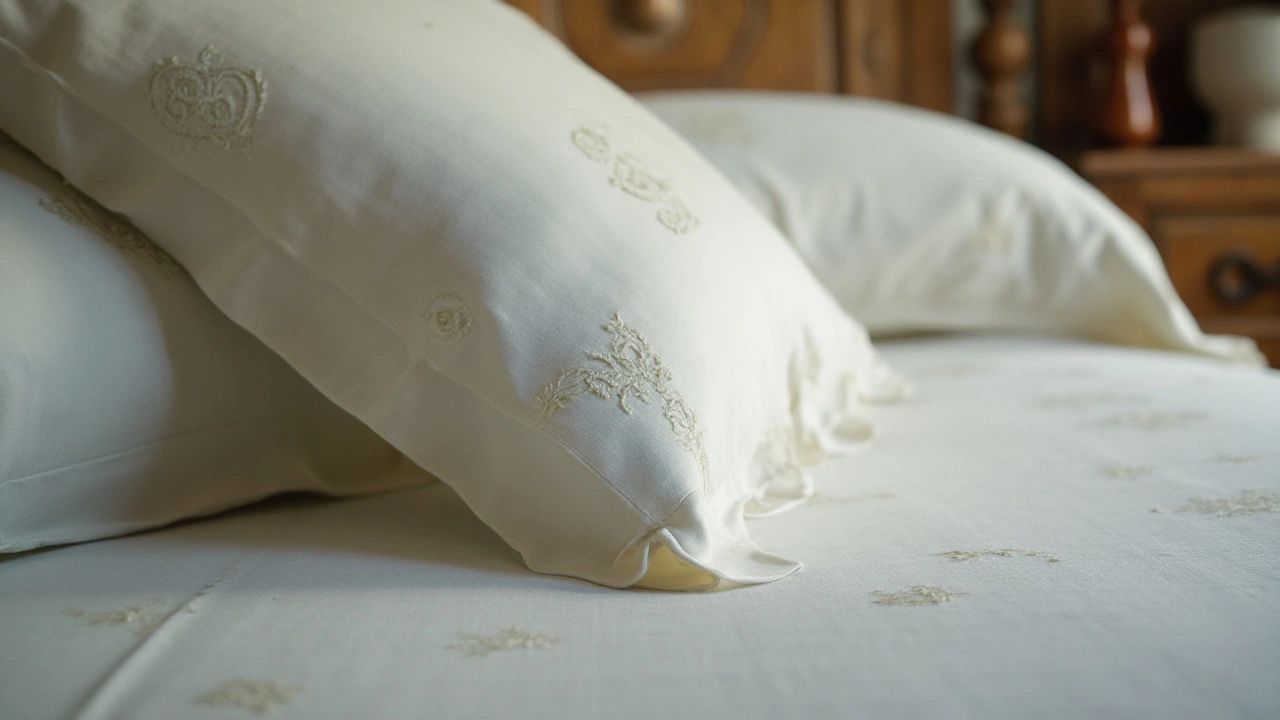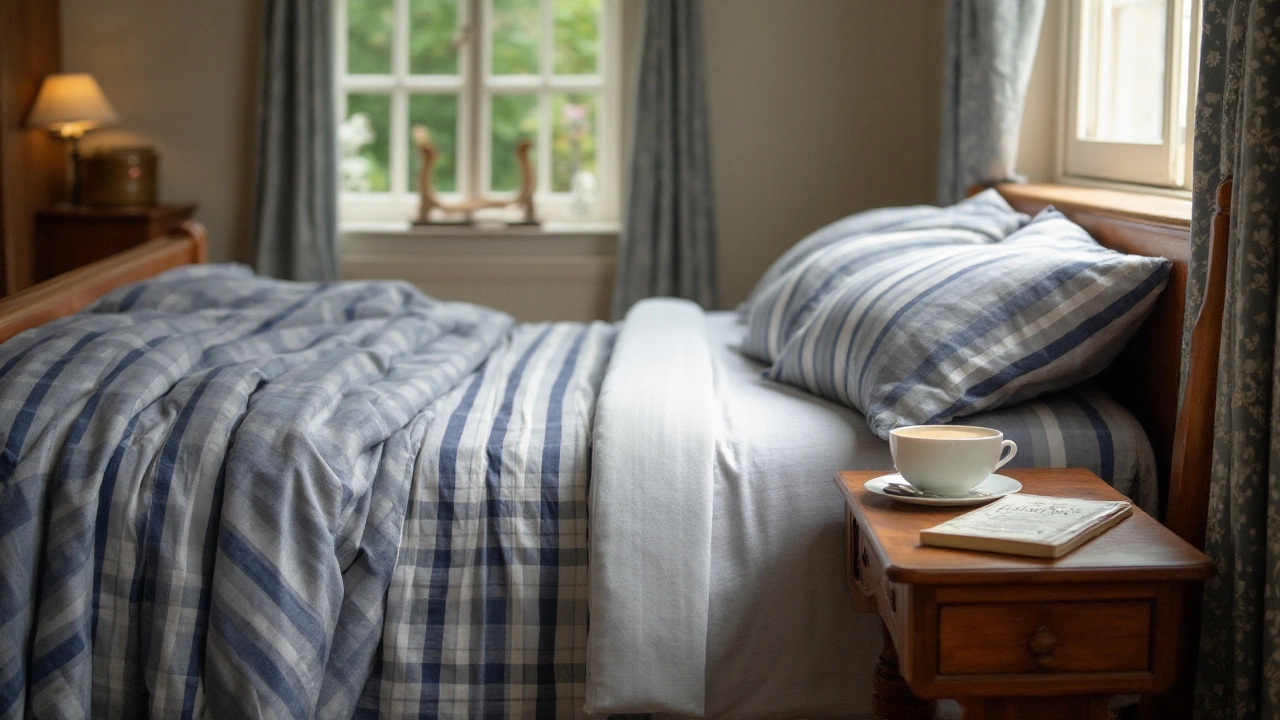In the realm of home decor, the term bedding is both familiar and inviting. Yet, the terminology surrounding it is often as diverse as the styles it embodies. Whether you're setting up a new home or refreshing your current space, understanding what bedding is really called can enhance your shopping experience and help you make more informed choices.
Bedding isn't just a mundane necessity; it is an expression of personal style, comfort, and practicality. Often referred to by names like bed linens or bedclothes, these elements play a significant role in ensuring a good night's sleep while also adding an aesthetic layer to your bedroom.
- Meaning of Bedding
- Common Terms for Bedding
- Historical Context of Bedding
- Different Types of Bedding
- Materials Used in Bedding
- Care Tips for Your Bedding
Meaning of Bedding
Bedding is a term that encapsulates all the materials used to dress and enhance a bed for both style and comfort. It includes an array of textiles and elements, each serving a particular purpose to ensure that bedtime is not merely a functional activity, but also a pleasurable and restorative experience. When we talk about bedding, we're diving into an age-old tradition that has evolved remarkably over the centuries, embodying the shifts in tastes, technology, and cultural preferences.
Historically, the materials and styles of bedding have been indicative of the prevailing cultural and social contexts. For instance, the ancient Egyptians are known to have been some of the early adopters of cotton in their bed linens, favoring its lightness and breathability to offset the severe heat of their climate. Medieval Europe saw the advent of feather-stuffed mattresses and canopies, indicating a shift towards greater comfort and luxury. These historic choices have informed our modern understanding of bedding, which emphasizes not just utility but also aesthetics and care.
In modern times, the specific components that comprise bed linens generally include sheets, blankets, comforters, quilts, pillowcases, and at times bed covers or duvet covers. Each piece is chosen according to its functional role and its ability to contribute to the overall aesthetic of a room. It's interesting to note that while sheets and pillowcases are more about direct contact and softness, layers like comforters and quilts contribute to warmth and decorative appeal. As such, choosing the right bedclothes is often a balance between tactile comfort, temperature regulation, and design preference.
"Bedding is not just an accessory, but an experience, a tactile engagement with the intimate territory we call sleep." – A quote from Linens Expert, Martha Collier
Today’s market offers a myriad of choices when it comes to styles and fabrics used in bedding. From traditional cotton and linen to modern microfiber and silk, each material presents its own unique benefits and characteristics. Cotton is celebrated for its softness and durability, linen for its luxury feel and temperature regulation, while silk adds an air of extravagance and comfort that few other materials can rival. Understanding these differences empowers consumers to make informed decisions that suit their personal needs and preferences. Shopping for bedding, therefore, becomes an exercise in personal expression as well as a commitment to one’s sleep health.
As more people recognize the importance of a good night's rest, the focus on quality bedding as a medium for enhanced sleep is growing. According to a 2023 survey by the Sleep Foundation, individuals who invested in higher-quality bed linens reported significantly improved sleep quality, emphasizing the role of bedding in fostering restorative sleep environments. This underscores the idea that the term bedding goes beyond just sheets and covers; it is a cornerstone of a healthy lifestyle, instrumental in achieving a restful escape from the day’s challenges. Bedding, thus, is an art of combining function, comfort, and personal style, reflecting our ever-evolving relationship with the spaces where we rest.
Common Terms for Bedding
In the delightful journey of bedding terminology, the array of terms can seem both familiar and surprising. Just as bedding itself transforms a simple mattress into a cozy retreat, the words we choose paint a picture of comfort in our minds. To delve into this lexicon is to uncover the diverse references that account for the variety and depth of what we know as bedding.
Take, for example, the term 'bed linens.' Widely used in households around the world, it extends beyond just sheets. It's an umbrella term that encapsulates the flat sheets, fitted sheets, pillowcases, and sometimes even duvet covers that adorn our beds. Then there's 'bedclothes,' a slightly less common phrase but one that equally hints at the clothing-like layers that dress our beds, offering warmth and color.
The evolution of these terms is as fascinating as the fabrics themselves. The term 'linens' originates from when such items were exclusively made of linen—a strong, natural fabric known for its breathability and durability. Although today, linens might refer broadly to items made from cotton or synthetic fibers, the original name persists, reflecting the rich tradition of textile craft. On this historic note, an older term still in use is 'bedding baudekin,' which referred to luxurious bedding materials used in European courts centuries ago. Though it's mostly fallen out of common parlance, its existence speaks to the opulent history of bed coverings.
Exploring Terms Globally
Globally, different cultures have embraced their own terms which add layers of intrigue. In Japan, for instance, the futon refers to a specific bedding style that includes layers of mattresses and covers designed to be folded and stored away during the day. This isn’t just a term for the entire sleeping set; it reflects a cultural lifestyle of compact living spaces and multifunctional rooms. In many parts of Europe, 'duvet' is a term more commonly used instead of 'comforter' in the United States, which refers to the soft, fluffy covering filled with down, feathers, wool, or synthetic fibers.
Some experts suggest that the terminology evolution is directly linked to the geographical adaptations and material availability of different regions. For example, the adaptation from feather-stuffed comforters to synthetic fiber duvets has driven not only manufacturing techniques but shifts in the language as well. The multiplicity of terms not only demonstrates the scope of bedding across different cultures but also the adaptability of language in response to evolving sleeping habits.
"Bedding is an expression of self, where we can fully authenticate our style, be it minimalistic, traditional, or eclectic." – Vanessa Marotis, Interior Design Expert
Understanding these terms can transform the task of shopping for bedding from daunting to delightful, as each name carries with it certain expectations about texture, warmth, and care. Sheets and covers are more than just fabric—they're a tangible expression of comfort and heritage, woven meticulously into our daily lives. By comprehending the vast vocabulary around bedding, we enrich not only our understanding of personal living spaces but the perpetual evolution of style and comfort found in our most intimate environments.

Historical Context of Bedding
Bedding, also referred to as bed linens or bedclothes, has a history as woven into the fabric of civilization as the sheets themselves. Dating back to ancient times, humans have always sought ways to make sleep more comfortable and restorative. Egyptians, known for their ingenuity, are credited with refining the art of linen making around 3000 B.C. They cultivated flax, a plant native to their land, to weave soft, lustrous sheets that signified both practicality and affluence. Sleeping on finely crafted bedding became not just a physical comfort but a statement of wealth and status.
As we move through history, the Middle Ages introduced a period where most people used simple straw mattresses or thin mats—an era not renowned for the luxury of sleep. In stark contrast, the wealthy and influential indulged in opulent sleeping arrangements. Rolling into the Renaissance, the fabric of choice was expanded to include silk, velvet, and damask, vividly illustrating a shift towards aesthetics in the bedroom ensemble. It's said that during this time, bedding entered into the realm of artistic expression, with richly embroidered coverlets and elegantly adorned sheets.
The industrial revolution marked a profound change with the advent of mechanization, allowing textiles like cotton to be produced more efficiently and sold on a larger scale. This democratized access to finer sheets and covers, fostering a culture where comfortable sheets no longer solely belonged to the aristocracy. The innovation continued with the introduction of synthetic fabrics in the 20th century, creating affordable and durable options.
Celia Haddon, a renowned historian, commented, "The bed became more than a place to sleep; it was a touchpoint for the personal revolutions that define our daily lives."
Fast forward to today, where we witness the bedding industry promoting sustainable and ethical practices. Organic cotton, bamboo, and other eco-friendly materials reflect a renewed respect for natural fibers while maintaining sumptuous comfort. Designers now focus on not just aesthetics but also the health benefits that these materials can offer, aiming to enhance the quality of our rest. It seems that in a society marked by swift advancements, the essence of bedding—to soothe, comfort, and rejuvenate—remains timeless.
This rich history is beautifully summarized by the myriad of styles and materials we find today, blending tradition with innovation and global influences. As we wrap ourselves in our bedding each night, we are enveloped by centuries of cultural significance, an often-overlooked chapter of human history that holds sway over our daily lives.
Different Types of Bedding
Bedding is much more than just a necessity for a good night's sleep; it is a testament to cultural evolution, lifestyle preferences, and personal comfort. Delving into the myriad types of bedding, one can uncover an expansive variety that caters to various tastes and climates. At its core, bedding can be classified into several types: sheets, blankets, comforters, duvets, quilts, and pillowcases, amongst others. Each serves a unique purpose, and often a well-made bed combines multiple layers for optimal comfort and aesthetics. Sheets typically include fitted and flat sheets, forming the foundation of your bedding ensemble, usually crafted from materials such as cotton, linen, or sateen, these sheets come in different weave styles and thread counts, impacting the sheet's feel and durability.
Comforters and duvets often cause confusion, yet they serve distinctive functions within a bedding set. A comforter is a thick, filled bedding piece that lies atop the bed. Often filled with down or synthetic fibers, it offers both warmth and bulk. Duvets, on the other hand, are a more modern solution, allowing for easily removable and washable covers, which can change with the seasons or your decor whims. Quilts, which have been cherished family heirlooms for centuries, typically consist of three layers: a woven cloth top, a filling, and a woven back. The unique stitching not only joins the layers but also creates picturesque designs.
"Bedding is the attire of your bedroom. It should comfort, entice, and tell a story all its own." - Unknown
Blankets and throws provide an additional layer of warmth and style and are crafted from materials ranging from fleece to wool, cotton, or blends. They are perfect for cuddling during chilly nights or adding a splash of color. Bed skirts and shams, though not part of functional bedding, contribute significantly to the overall appearance of the bed, concealing under-bed storage or bed frames while adding a tailored look. Indeed, bedding encompasses an extensive range of elements, each playing a role larger than mere utility. Through different types of bedding, we discover how comfort meets aesthetics and fulfills diverse aspects of human need and preference.

Materials Used in Bedding
When it comes to bedding, the choice of materials can make a world of difference, both in terms of comfort and longevity. There are various materials used for bedding, each with characteristics that cater to different sleeping preferences and climates. Understanding these materials can aid in selecting bedding that suits your personal needs and enhances your sleep quality. The most popular materials include cotton, linen, silk, polyester, and bamboo. Each of these materials offers distinct benefits and a unique feel, making them favored by different people for different reasons.
Cotton is a classic choice known for its breathability and softness. This natural fiber is durable and can be woven into different types of fabrics such as sateen and percale, offering versatility in terms of texture and finish. Cotton's ability to wick away moisture makes it an excellent option for those who sleep hot or live in warmer climates. Organic cotton, grown without the use of synthetic chemicals, is becoming increasingly popular among environmentally-conscious consumers. Meanwhile, Egyptian cotton, with its long-staple fibers, is often regarded as the pinnacle of luxury due to its supreme softness and elegance.
Moving along to linen, a material derived from the flax plant, is celebrated for its exceptional breathability and durability. Linen bedding is ideal for those who prefer a more rustic, lived-in aesthetic as it has a slightly crinkled look that adds character to any bedroom setting. Although linen is usually more expensive, it becomes softer with each wash and can last for decades, making it a worthy investment.
Linen holds a special place in sustainable home décor, as it is one of the most eco-friendly materials around, requiring significantly less water and pesticides compared to cotton.
On the other end of the spectrum, silk is synonymous with luxury and opulence. Its naturally hypoallergenic properties make it an excellent choice for those with sensitive skin. Silk bedding drapes beautifully on the bed and lends a touch of elegance to any bedroom. It is incredibly smooth and has a unique ability to regulate temperature, keeping you warm during chilly nights and cool during warm nights. However, silk requires delicate care and is significantly more expensive than other materials.
For those seeking more budget-friendly and hypoallergenic options, polyester and its blends, such as microfiber, offer an accessible alternative. Polyester is a synthetic fiber that is durable, wrinkle-resistant, and easy to care for. Although it may not be as breathable as natural fibers, today's advancements in fabric technology have led to innovations like brushed microfiber, which can mimic the softness of higher-end fabrics. Bamboo bedding is gaining popularity due to its silky texture and eco-friendliness. Made from the pulp of bamboo plants, it is often blended with other materials to enhance its strength and durability. Bamboo is praised for its breathability and ability to wick moisture, making it a suitable option for those prone to night sweats.
Opting for the right bedding material largely depends on personal preference. While some emphasize the importance of natural fibers and their breathability, others might prioritize easy maintenance and cost-effectiveness. No matter the material chosen, the right bedding can transform not only the look of your bedroom but also the quality of your sleep, creating a sanctuary of peace and relaxation.
Care Tips for Your Bedding
Caring for your bedding is an essential part of maintaining a cozy and inviting bedroom. It ensures the longevity of your investment and can significantly improve the sleeping experience. A key aspect of caring for bedding involves regular washing, as it not only keeps your bed linens fresh but also promotes a healthier sleep environment by eliminating dust mites and allergens. To preserve the quality of your sheets and pillowcases, it's advisable to wash them every one to two weeks. When doing so, ensure you're using the correct settings on your washing machine.
Using cool or warm water can help prevent the fibers of your bed linens from breaking down prematurely, while a gentle cycle reduces wear and tear. It's always a good idea to check the manufacturer's label for specific washing instructions. Another important tip is to avoid overloading your washing machine. This allows each item to move freely and get properly cleaned. When it comes to drying, try to opt for a low heat setting or air drying, as high heat can cause significant damage to the fabric over time.
Proper storage also plays a vital role in extending the life of your bedclothes. Once clean and completely dry, your bedding should be stored in a cool, dry place to prevent any musty odors or mold growth. Some people find it useful to store their sets in breathable cotton bags, as they protect the fabric while keeping them fresh. If you're dealing with limited space, storing bedding inside a pillowcase from the same set is a clever trick that keeps everything organized and easy to find.
Ironing can be an optional step in maintaining your sheets and bedclothes. While some people appreciate the crispness it brings, others might prefer the natural feel. If you do choose to iron, ensure that the setting matches the type of material you're dealing with. Cotton, for instance, can withstand higher heat than materials like silk. As a general rule of thumb, use a pressing cloth to avoid direct heat contact on delicate fabrics. Regular ironing can also help in achieving that beautiful, polished look often associated with perfectly made beds.
"A good night's sleep starts with clean and comfortable bedding," says Sara Peterson, an expert home decor writer at 'Home Sweet Home' Magazine. Her advice emphasizes the psychological benefits of sleeping in a well-maintained environment, which can contribute to improved mood and overall well-being.
Lastly, rotating your bedding is another useful tip. If you have multiple sets, try to rotate them frequently to ensure even usage and wear. This not only prolongs the life of your favourite sheets but also means you'll always have a clean set at hand. Additionally, don't forget to pay attention to stain removal. Treating spills quickly with a mixture of mild detergent and water can stop stains from setting in. These small efforts ensure that your sheets continue to be a source of comfort and aesthetics in your home.

